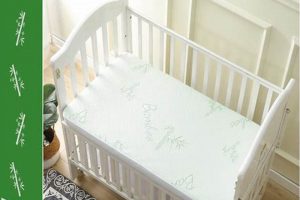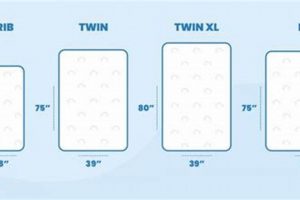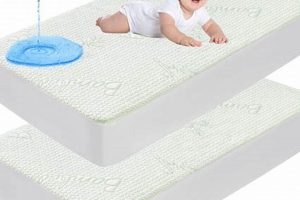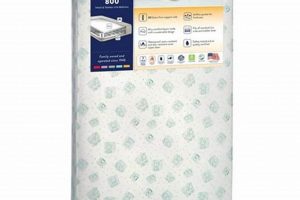The length of a standard crib mattress is generally 52 inches. This dimension is crucial to ensure a safe and snug fit within a standard-sized crib frame, minimizing the risk of entrapment for the infant. For example, a mattress significantly shorter than 52 inches could leave dangerous gaps between the mattress edge and the crib sides.
This specific length is important for infant safety and comfort. Historically, standardization in crib mattress sizes has been implemented to reduce accidents and promote consistent manufacturing practices. A properly sized mattress provides a firm, flat surface, which is essential for a baby’s healthy development and reduces the risk of Sudden Infant Death Syndrome (SIDS).
The following sections will delve deeper into different types of crib mattresses, factors to consider when selecting one, and potential variations in size that may exist beyond the standard measurement. Information on testing standards and safety regulations will also be explored.
Selecting the Correct Crib Mattress Length
Choosing a crib mattress of the appropriate length is paramount for infant safety. These tips offer guidance on ensuring the correct fit within a standard crib frame.
Tip 1: Verify Standard Dimensions: Confirm the crib mattress adheres to the standard 52-inch length. This ensures compatibility with most standard-sized cribs.
Tip 2: Measure Internal Crib Dimensions: Before purchasing a mattress, measure the inside length of the crib. This confirms the internal dimensions align with the standard mattress size.
Tip 3: Assess Gap Size: After placing the mattress in the crib, check for gaps between the mattress edge and the crib frame. Gaps exceeding two fingers’ width pose a safety hazard.
Tip 4: Review Product Specifications: Carefully examine the manufacturer’s specifications for the mattress. Confirm the stated length matches the required standard before purchase.
Tip 5: Consider Mattress Firmness: A firm mattress provides optimal support. Ensure the chosen mattress does not sag excessively, even when compressed.
Tip 6: Research Certifications: Look for certifications from reputable organizations. These indicate the mattress has undergone testing and meets safety standards.
Tip 7: Prioritize Safety Over Cost: While budget is a factor, infant safety should be the primary consideration. Invest in a mattress that meets safety standards and offers proper support.
Adhering to these tips ensures a safe sleeping environment for the infant, minimizing potential hazards associated with an improperly sized crib mattress.
The concluding sections will summarize key considerations and offer final recommendations for selecting a suitable crib mattress.
1. Standard Length
The phrase “how long is a crib mattress” invariably points to the standardized length of 52 inches. This dimension is not arbitrary; it is a critical component of established safety regulations for infant bedding. The designation of 52 inches as the standard length is a direct response to the need for crib mattresses to fit securely within standardized crib frames. Without this defined length, manufacturers could produce mattresses of varying sizes, leading to potentially hazardous gaps between the mattress and the crib sides. These gaps pose a suffocation or entrapment risk to infants. For instance, a crib marketed as “standard” but accommodating a mattress shorter than 52 inches compromises infant safety, directly violating the intent of safety standards.
The 52-inch standard has a tangible impact on crib and mattress design. Crib manufacturers engineer their products to accommodate this specific mattress dimension, ensuring a snug and secure fit. Mattress manufacturers, in turn, adhere to this standard to ensure their products are compatible with the vast majority of cribs on the market. This uniformity allows caregivers to select a crib and mattress with confidence, knowing that the dimensions are designed to work together effectively. Testing and certification processes further reinforce this link, with products undergoing scrutiny to confirm adherence to the 52-inch standard and other safety criteria. Real-world instances of non-compliant mattresses resulting in infant injury underscore the importance of this standardized dimension.
In summary, the 52-inch standard length directly addresses the question “how long is a crib mattress,” serving as a cornerstone of infant safety in crib design and manufacturing. The consistent application and enforcement of this standard mitigate risks associated with improperly sized bedding. Challenges remain in preventing the sale of non-compliant products; however, a continued focus on education, regulation, and rigorous testing is vital to ensuring that all crib mattresses adhere to this fundamental safety requirement.
2. Tolerance Range
The allowable tolerance range of plus or minus 0.5 inches surrounding the standard crib mattress length of 52 inches directly influences the safety and functionality of the product. This narrow margin acknowledges manufacturing variability while maintaining critical safety standards.
- Dimensional Compliance
This tolerance specifies the acceptable deviation from the 52-inch standard, allowing manufacturers leeway in production. A mattress measuring 51.5 inches or 52.5 inches falls within compliance. Exceeding this range results in a non-compliant product, potentially creating unsafe gaps. For example, a mattress measuring 53 inches would be deemed unsuitable and unsafe for standard cribs.
- Safety Margin
The +/- 0.5-inch tolerance serves as a safety buffer. It acknowledges that absolute precision in manufacturing is often unattainable while ensuring that deviations remain within acceptable safety parameters. Gaps exceeding approximately two fingers’ width between the mattress and crib frame can pose an entrapment risk. The tolerance range minimizes the potential for gaps of this size, even with slight manufacturing inconsistencies.
- Manufacturing Process Considerations
This tolerance range allows for variations in materials and manufacturing processes. Different materials may expand or contract slightly depending on environmental factors. The tolerance accommodates these natural variations while still requiring adherence to the primary dimensional standard. A manufacturer using softer materials might aim for the upper end of the tolerance range to ensure adequate filling of the crib space.
- Testing and Certification
Testing and certification bodies utilize the +/- 0.5-inch tolerance as a key criterion for product evaluation. Mattresses are measured to confirm they fall within the acceptable range. Products failing to meet this requirement do not receive certification, preventing their sale as compliant crib mattresses. Rigorous testing reinforces the importance of adhering to this tolerance for safety assurance.
Therefore, the tolerance range of plus or minus 0.5 inches is intrinsically linked to the issue of “how long is a crib mattress.” It balances manufacturing realities with essential safety requirements, ensuring that even with slight production variations, crib mattresses provide a secure sleeping environment for infants.
3. Internal Crib Size
The premise that the internal crib size must match the mattress length is a fundamental principle directly answering “how long is a crib mattress,” prioritizing infant safety by ensuring a secure fit and preventing potential hazards.
- Eliminating Entrapment Risks
The primary function of matching internal crib size to the mattress length is to eliminate gaps. If the internal dimensions of the crib exceed the mattress length, dangerous spaces form, posing a risk of infant entrapment. For instance, a crib with an internal length of 53 inches paired with a standard 52-inch mattress creates a hazardous gap. Such gaps could lead to limb entrapment or, in severe cases, suffocation if an infant becomes wedged between the mattress and the crib frame.
- Maintaining Consistent Support
A matching crib and mattress ensure uniform support across the entire sleep surface. An undersized mattress within a larger crib can create uneven weight distribution, potentially leading to sagging or tilting. This compromises the intended firmness of the mattress, which is crucial for proper infant development and reducing the risk of SIDS. If the mattress doesn’t fully occupy the space, it may not provide adequate spinal support.
- Adhering to Regulatory Standards
Regulatory bodies mandate that crib and mattress dimensions align to minimize safety risks. These standards often specify maximum allowable gap sizes between the mattress and crib sides. A mismatched crib and mattress inherently violate these regulations, exposing manufacturers and retailers to liability. For example, the Consumer Product Safety Commission (CPSC) in the United States has strict guidelines regarding crib dimensions and mattress fit, and non-compliance can result in recalls and penalties.
- Promoting Product Longevity
A correctly sized mattress promotes the longevity of both the crib and the mattress itself. An ill-fitting mattress can place undue stress on the crib frame, potentially weakening joints or causing structural damage over time. Conversely, a tightly packed mattress may compress and degrade faster than intended. A matched set distributes wear evenly, contributing to the durability of both products.
In conclusion, the critical relationship between internal crib size and mattress length underscores the importance of precision when considering “how long is a crib mattress.” Adherence to this principle is paramount for infant safety, regulatory compliance, product longevity, and overall parental peace of mind. Ensuring a secure and snug fit remains a non-negotiable aspect of infant bedding selection.
4. Gap Prevention
The phrase “Gap Prevention: Critical Importance” is inextricably linked to the consideration of “how long is a crib mattress” due to the direct correlation between mattress dimensions and infant safety. The length of a crib mattress, typically standardized at 52 inches, is intended to provide a snug fit within a standard crib frame. Any deviation from this dimension, or a mismatch between crib and mattress size, results in gaps. These gaps pose a significant entrapment hazard for infants. Limbs can become lodged between the mattress edge and the crib rails, leading to potential injury or, in the most severe cases, suffocation. The critical nature of gap prevention thus dictates the importance of adhering to standardized mattress lengths.
Real-life examples underscore the potential dangers associated with inadequate gap prevention. Case studies have documented instances of infants becoming trapped and injured due to oversized gaps between the mattress and the crib. These incidents have led to heightened regulatory scrutiny and stricter enforcement of safety standards related to crib and mattress manufacturing. The practical significance of understanding “Gap Prevention: Critical Importance” lies in the ability of caregivers to make informed purchasing decisions. Careful measurement of the internal crib dimensions and verification of mattress length are essential steps in ensuring a safe sleep environment. Moreover, ongoing monitoring for the development of gaps, such as through mattress compression over time, is crucial for maintaining infant safety.
In summary, the necessity of “Gap Prevention: Critical Importance” solidifies the relevance of properly addressing “how long is a crib mattress.” Adherence to standardized mattress lengths, coupled with diligent monitoring for gaps, is paramount in safeguarding infant well-being. While manufacturing standards aim to mitigate the risk of gaps, the ultimate responsibility rests with caregivers to ensure a secure sleep environment. Further advancements in crib and mattress design should prioritize gap reduction and enhanced safety features.
5. Safety Standards
The concept of “Safety Standards: Compliance Required” is fundamentally intertwined with addressing “how long is a crib mattress.” Mandatory safety standards dictate the permissible dimensions of crib mattresses to mitigate potential hazards and safeguard infant well-being. Strict adherence to these standards is not optional but a legal and ethical obligation for manufacturers and retailers.
- Mandatory Dimensional Requirements
Regulatory bodies, such as the Consumer Product Safety Commission (CPSC) in the United States, establish specific dimensional requirements for crib mattresses. These standards precisely define the permissible length, width, and thickness of mattresses intended for use in standard-sized cribs. Failure to comply with these dimensional specifications constitutes a violation of safety regulations, potentially leading to product recalls and legal penalties. For example, a mattress exceeding the maximum allowable length could create a hazardous condition by preventing the proper closure of crib sides.
- Gap Size Restrictions
Safety standards explicitly address the issue of gap size between the mattress and the crib frame. Regulations stipulate the maximum permissible gap to prevent infant entrapment. A crib mattress that is too short or narrow, resulting in gaps exceeding the regulatory threshold, fails to meet safety standards. These restrictions directly impact the question of “how long is a crib mattress,” as the length must be within the specified range to minimize the risk of limb entrapment. Routine inspections and testing procedures are conducted to ensure compliance with these gap size limitations.
- Material and Construction Standards
In addition to dimensional requirements, safety standards govern the materials and construction techniques employed in crib mattress manufacturing. Regulations restrict the use of certain chemicals and materials that may pose a health risk to infants. Furthermore, construction standards mandate specific levels of firmness and support to reduce the risk of Sudden Infant Death Syndrome (SIDS). While not directly related to length, these material and construction standards complement dimensional requirements in ensuring overall product safety and are integral to complete compliance.
- Testing and Certification Protocols
To demonstrate compliance with safety standards, crib mattresses undergo rigorous testing and certification processes. Independent testing laboratories evaluate mattresses against established safety criteria, including dimensional accuracy, gap size limitations, and material composition. Products that successfully pass these tests receive certification, indicating their adherence to regulatory requirements. This certification provides assurance to consumers that the mattress meets established safety standards and addresses the core aspects of “how long is a crib mattress” in relation to safe product design.
In conclusion, the rigorous framework of “Safety Standards: Compliance Required” directly influences the consideration of “how long is a crib mattress” and encompasses a holistic approach to infant safety. Adherence to dimensional specifications, gap size restrictions, material standards, and testing protocols is essential for ensuring that crib mattresses provide a secure and healthy sleep environment for infants. Non-compliance carries significant consequences, underscoring the imperative for manufacturers and retailers to prioritize safety in all aspects of crib mattress design and production.
6. Firmness Impact
The firmness of a crib mattress and the consistency of its support are intrinsically linked to the appropriate length of the mattress within the crib frame. A correctly sized mattress (addressing “how long is a crib mattress”) is essential for ensuring the designed firmness level is maintained across the entire sleep surface, thereby promoting infant safety and proper development.
- Even Weight Distribution
A crib mattress of the correct length ensures that an infant’s weight is evenly distributed across the entire surface. An undersized mattress within the crib frame can lead to uneven weight distribution, potentially causing sagging in certain areas. This inconsistency in support can compromise the designed firmness and increase the risk of positional asphyxia. A mattress that fully occupies the intended space provides consistent support, regardless of the infant’s position.
- Prevention of Sagging and Gaps
A mattress of insufficient length can contribute to the formation of gaps between the mattress and the crib sides, as well as increase the likelihood of sagging in the central area. This sagging compromises the intended firmness and creates an uneven sleep surface, potentially hindering proper spinal alignment. The correct length, conforming to safety standards, minimizes these risks, ensuring a flat and firm surface as recommended by pediatricians.
- Influence on Spinal Alignment
Consistent firmness is vital for maintaining proper spinal alignment during infant sleep. A mattress that sags or is not uniformly firm can place undue stress on the infant’s spine, potentially leading to discomfort or developmental issues. A mattress of the appropriate length, adhering to dimensional requirements, helps to maintain the intended firmness, promoting healthy spinal development. The length thus plays an indirect but significant role in ensuring consistent support.
- Impact on SIDS Risk Reduction
A firm, flat sleep surface is recommended to reduce the risk of Sudden Infant Death Syndrome (SIDS). A mattress lacking consistent firmness due to incorrect length or sagging can create pockets or indentations that increase the risk of suffocation. By ensuring the correct mattress length and consistent support, caregivers can create a safer sleep environment, mitigating some of the risk factors associated with SIDS. The correct length helps maintain the firmness necessary to reduce this risk.
In conclusion, the connection between firmness impact and support consistency highlights the importance of addressing “how long is a crib mattress.” A correctly sized mattress, in accordance with safety standards, is fundamental for maintaining consistent support, preventing sagging, promoting proper spinal alignment, and reducing the risk of SIDS. The mattress length directly contributes to the overall firmness and safety of the sleep environment, underscoring its critical role in infant care.
7. Measuring Accurately
The phrase “Measuring Accurately: Essential Step” is inextricably linked to the critical consideration of “how long is a crib mattress.” Determining the accurate length of a crib mattress is not merely a matter of convenience; it is a fundamental prerequisite for ensuring infant safety and regulatory compliance. Incorrect measurements can lead to the selection of a mattress that does not properly fit the crib frame, creating hazardous gaps. These gaps, even if seemingly small, pose a significant risk of entrapment, potentially causing injury or, in extreme cases, suffocation. Therefore, the act of precise measurement is a vital preventative measure against these potential dangers. For instance, a caregiver estimating the length instead of using a measuring tape might purchase a mattress that is shorter than required, unwittingly compromising the infant’s safety.
The practical significance of understanding “Measuring Accurately: Essential Step” extends to several key areas. Firstly, it enables consumers to verify the manufacturer’s stated dimensions. Discrepancies between advertised length and actual length can occur, and accurate measurement empowers caregivers to identify and address such inconsistencies. Secondly, precise measurement is crucial when using a crib that is not of standard dimensions. Antique cribs or those constructed by hand may deviate from standardized measurements, necessitating careful assessment to ensure a secure and safe fit. Thirdly, accurate measurement facilitates ongoing monitoring of the mattress and crib over time. Mattresses can compress or crib frames can warp, leading to the development of gaps even if the initial fit was appropriate. Periodic remeasurement allows for the early detection of these issues, enabling timely intervention.
In summary, “Measuring Accurately: Essential Step” is not simply a preliminary task but a continuous process intrinsically linked to the question of “how long is a crib mattress.” It is a core component of ensuring infant safety, verifying product compliance, and maintaining a secure sleep environment. The challenges associated with imprecise measurement underscore the need for diligence, attention to detail, and the use of appropriate tools when selecting and maintaining a crib mattress. This proactive approach mitigates risks and promotes the well-being of the infant.
Frequently Asked Questions
The following questions address common inquiries regarding crib mattress dimensions, focusing on the critical importance of selecting a mattress of the appropriate size to ensure infant safety and regulatory compliance.
Question 1: What is the standard length for a crib mattress?
The standard length for a crib mattress is 52 inches. This dimension is a critical component of safety regulations designed to minimize the risk of infant entrapment within the crib.
Question 2: Is there an acceptable tolerance range for crib mattress length?
Yes, an acceptable tolerance range exists around the standard 52-inch length. The permissible deviation is typically plus or minus 0.5 inches. Mattresses falling outside this range may pose a safety risk.
Question 3: Why is the correct crib mattress length so important?
The correct length is crucial to prevent gaps between the mattress and the crib frame. Gaps can lead to limb entrapment or suffocation, making accurate dimensions a primary safety concern.
Question 4: How should the internal crib dimensions be measured?
The internal crib dimensions should be measured from the inside of one crib side to the inside of the opposite side, ensuring the measuring tape is level and taut. Accuracy is paramount in this process.
Question 5: What are the potential consequences of using a crib mattress of incorrect length?
Using a mattress of incorrect length can lead to gaps, increasing the risk of infant entrapment and injury. It also represents a violation of safety standards, potentially resulting in legal liabilities for manufacturers and retailers.
Question 6: Where can information on crib mattress safety standards be found?
Information on crib mattress safety standards is generally available from regulatory bodies, such as the Consumer Product Safety Commission (CPSC) in the United States, and from reputable testing and certification organizations.
In summary, understanding the significance of proper crib mattress dimensions is paramount for ensuring a safe sleep environment. Adherence to safety standards and accurate measurements are essential preventative measures.
The subsequent section provides guidance on selecting appropriate crib mattresses based on specific needs and safety considerations.
Crib Mattress Length
The foregoing analysis has detailed the critical importance of adhering to standardized dimensions when considering crib mattresses. The phrase “how long is a crib mattress” extends beyond a mere inquiry about physical size. It encompasses a comprehensive understanding of regulatory standards, safety implications, and the potential consequences of non-compliance. The standard length of 52 inches, along with its permissible tolerance, is not arbitrary; it is a meticulously designed parameter intended to minimize the risk of infant entrapment and suffocation.
The information presented serves as a call to vigilance. Caregivers are urged to prioritize precise measurement and thorough verification of product specifications. Manufacturers and retailers are reminded of their unwavering responsibility to uphold safety standards. The well-being of infants depends upon the collective commitment to ensuring that crib mattresses conform to established safety guidelines. Continued vigilance and a steadfast dedication to safety are imperative for safeguarding the most vulnerable members of society.







